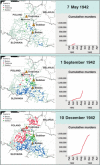Quantifying the Holocaust: Hyperintense kill rates during the Nazi genocide
- PMID: 30613773
- PMCID: PMC6314819
- DOI: 10.1126/sciadv.aau7292
Quantifying the Holocaust: Hyperintense kill rates during the Nazi genocide
Abstract
Operation Reinhard (1942-1943) was the largest single murder campaign of the Holocaust, during which some 1.7 million Jews from German-occupied Poland were murdered by the Nazis. Most perished in gas chambers at the death camps Belzec, Sobibor, and Treblinka. However, the tempo, kill rates, and spatial dynamics of these events were poorly documented. Using an unusual dataset originating from railway transportation records, this study identifies an extreme phase of hyperintense killing when >1.47 million Jews-more than 25% of the Jews killed in all 6 years of World War II-were murdered by the Nazis in an intense,100-day (~3-month) surge. Operation Reinhard is shown to be an extreme event, based on kill rate, number, and proportion (>99.9%) of the population murdered in camps, highlighting its singularly violent character, even compared to other more recent genocides. The Holocaust kill rate is some 10 times higher than estimates suggested by authorities on comparative genocide.
Figures





References
-
- R. Hilberg, The Destruction of the European Jews (Yale Univ. Press, 2003).
-
- Y. Arad, Belzec, Sobibor, Treblinka—The Operation Reinhard Death Camps (Indiana Univ. Press, 1987).
-
- Y. Gutman, Jews of Warsaw 1939-1943: Ghetto, Underground, Revolt (Indiana University Press, 1989).
-
- D. Cesarani, Final Solution: The Fate of the Jews 1933-1949 (Macmillan, 2016).
-
- M. Gilbert, The Holocaust: A History of the Jews of Europe During the Second World War (Holt, Rinehart & Winston, 1985).
Publication types
MeSH terms
LinkOut - more resources
Full Text Sources

